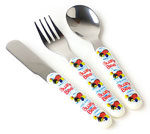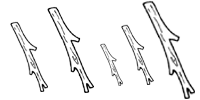
|
|
Training Effective Use of Vision
Awareness and Attention to Detail
Patterns, Letters, Numbers and Words
Activities to Encourage the Use of Vision
Discrimination of details to identify objects, actions and match objects
When looking at objects, talk about what makes them different. Discuss the things about them that tell you what they are. For example a knife, fork and spoon are similar but the end is different on each; a bowl for eating is different to one for cooking and a basket has handles so that you can carry it.
Look at the important parts on objects. For example, the latch or handle on a door, the sharp part of a knife or the part of the pen you write with.
Imitation of body movements. Start with moving the whole body, then large movement of the arms or legs, then small parts of the body such as the head. Smaller movements with hands and fingers are more difficult to see and copy. Work close to the person then move further away.
Examples of movement are:
- whole body - bending over, turning around
- arm or leg - kicking or throwing
- hand and finger - screwing hand into a fist, pointing.
Special ways of holding objects may need to be taught. Sometimes it is better to use the whole hand to pick up something or other times to use the thumb and first finger.
Imitation of expressions of the face. Start by working close to the person (less than 1 metre). Make expressions to be copied - closing both eyes, opening and closing the mouth and smiling.
Recognition of familiar people. People are normally recognised by their faces. If a person with low vision cannot normally get close enough to recognise another person, they need to learn other ways of identifying people. Other features such as voices, clothes or size and shape can help to identify people.
Recognition of animals. Animals are recognised by their shape, size, colour or special parts of them. Animals that are similar such as birds have different things such as beaks. Animals with 4 legs and similar size are recognised by such things as the shape of the head or tail. Point out these differences in animals found in your environment.
Parts of objects and how they go together to make a whole object. Look at parts of an object and show how they fit into the whole object. For example with vehicles such as a car, boat or bike - look at all the parts and talk about how they are used.
Play hiding games with part of the object still showing. For example a person can stand behind a doorway with part of her still showing or hide a familiar object partly behind another. Make it harder by hiding more of the object with only a small part showing.
Identifying objects that belong together. From a collection of different objects, put all the things together that are the same kind or used for the same thing. In a house it could be all the objects used in cooking; in a school, all the things for drawing or writing but not the books.
Matching and sorting the length of objects. Start with only two sizes - short and long then later add more sizes. Use objects that the person will need to use that are different lengths. Examples are sticks or wood for building and twine or string for tying up objects.
Matching objects by size. Start with only two sizes - big and little then later add in-between sizes. Objects which are the same type but different sizes should be used. These could be fruit or vegetables, feathers or beads. Sort objects and put them in separate boxes or bowls. For example put all the small beads in the small bowl and all the large beads in the large bowl.
|
|
| Visual Communication Unit |




